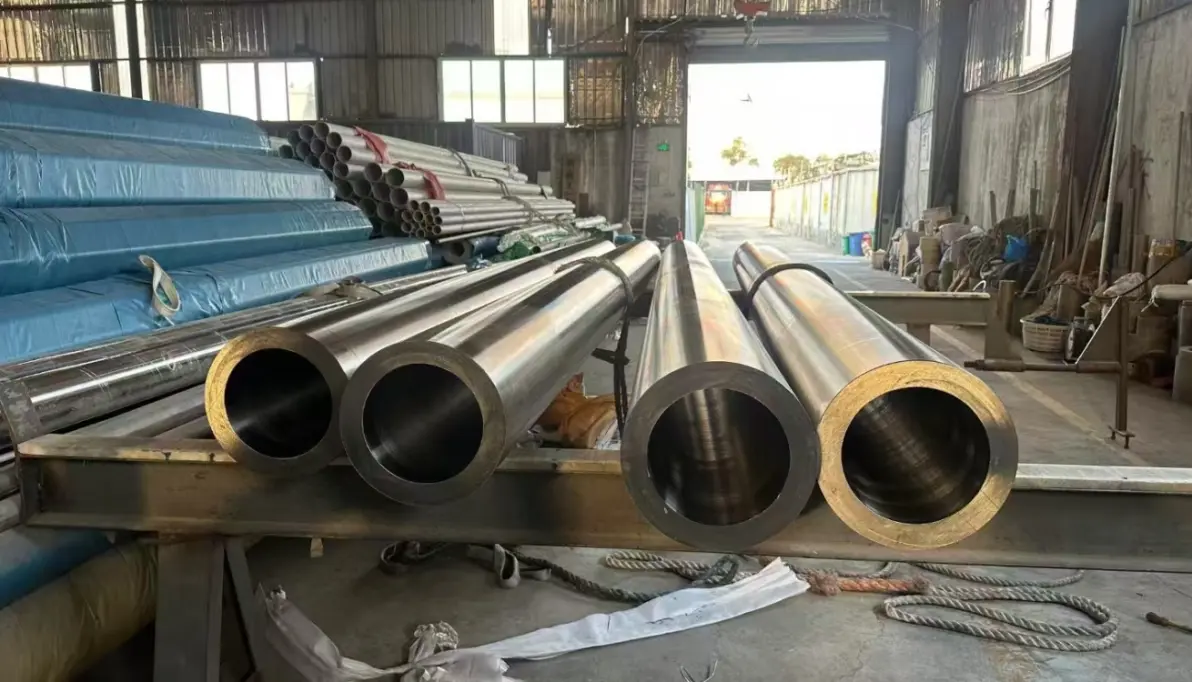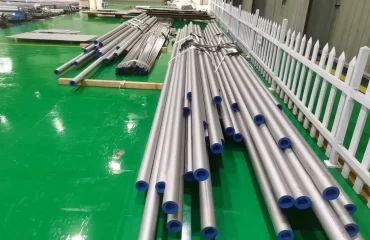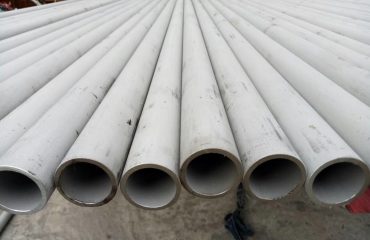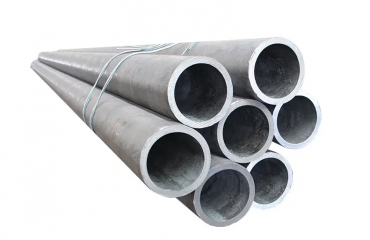
Alloy C276 Pipe Bursting Pressure Tables
Introduction to Alloy C276 Pipes
Alloy C276, also known as Hastelloy C276, UNS N10276, or W.Nr. 2.4819, is a nickel-molybdenum-chromium superalloy renowned for its exceptional corrosion resistance and high strength in extreme environments. Widely used in chemical processing, oil and gas, and marine applications, it resists pitting, crevice corrosion, and stress-corrosion cracking (SCC) in aggressive media like chlorides and acids. Alloy C276 pipes, available in seamless (ASTM B622) and welded (ASTM B626) forms, are critical for high-pressure systems where reliability is paramount. Bursting pressure tables, calculated using Barlow’s Formula, provide theoretical internal pressures that pipes can withstand before failure, guiding engineers in selecting appropriate pipe schedules for specific applications.
The alloy’s versatility stems from its balanced composition and robust mechanical properties, making it suitable for pipes in sizes ranging from 1/8 inch to 30 inches in diameter. Bursting pressure data, sourced from reputable suppliers like Corrosion Materials and NeoNickel, indicate pressures as high as 35,175 PSI for small-diameter, thick-walled pipes (e.g., 1/8 inch, Schedule 80S). This article details Alloy C276’s chemical composition, mechanical properties, corrosion resistance, manufacturing processes, applications, and bursting pressure tables, with comparisons to Inconel 625, Alloy 20, ASTM A671 CC60, and API 5L PSL2 BNS. A comprehensive table summarizes bursting pressures and key parameters, ensuring a valuable resource for engineers.
Chemical Composition and Material Analysis
Alloy C276’s chemical composition is optimized for corrosion resistance and strength. It contains nickel (balance, ~55–57%), molybdenum (15.0–17.0%), chromium (14.5–16.5%), iron (4.0–7.0%), tungsten (3.0–4.5%), cobalt (≤2.5%), manganese (≤1.0%), carbon (≤0.01%), silicon (≤0.08%), phosphorus (≤0.04%), sulfur (≤0.03%), and vanadium (≤0.35%). The high molybdenum content enhances resistance to pitting and crevice corrosion in chloride environments, while chromium provides oxidation resistance. Low carbon and silicon minimize carbide precipitation during welding, ensuring weld integrity. Tungsten adds strength and corrosion resistance in reducing acids.
Compared to Inconel 625 (58% min nickel, 8–10% molybdenum), Alloy C276 has higher molybdenum, offering superior resistance to localized corrosion but slightly lower strength. Alloy 20 (32–38% nickel, 2–3% molybdenum, 3–4% copper) excels in sulfuric acid but is less effective in chlorides. ASTM A671 CC60 (0.04–0.27% carbon, 0.85–1.20% manganese) and API 5L PSL2 BNS (≤0.12% carbon) are carbon steels with minimal alloying, relying on coatings for corrosion protection. Alloy C276’s austenitic structure ensures ductility and toughness, supporting its use in high-pressure pipes. The composition’s low impurity levels and stabilization make it ideal for welded pipes, as seen in bursting pressure tables, where weld integrity is critical for high-pressure performance.
Mechanical Properties
Alloy C276 pipes exhibit excellent mechanical properties, supporting their use in high-pressure applications. In the annealed condition, seamless pipes (ASTM B622) have a minimum tensile strength of 690 MPa (100 ksi), yield strength of 283 MPa (41 ksi), and elongation of 40%. Welded pipes (ASTM B626) have similar properties, with tensile strength ≥690 MPa and yield ≥283 MPa, though cold-working can increase strength (e.g., up to 1000 MPa tensile for cold-hardened pipes). Hardness is typically 185–230 Brinell. These properties are maintained up to 450°F (232°C), with good performance at higher temperatures for short-term exposure.
Compared to Inconel 625 (tensile 827 MPa, yield 414 MPa), Alloy C276 has slightly lower strength but better corrosion resistance in reducing environments. Alloy 20 (tensile 551 MPa, yield 241 MPa) is weaker but optimized for acid resistance. ASTM A671 CC60 (tensile 415–550 MPa, yield 220 MPa) and API 5L PSL2 BNS (tensile 415–760 MPa, yield 245 MPa) are significantly weaker, designed for low-temperature or sour service pipelines. Bursting pressure tables reflect Alloy C276’s high strength, with Schedule 80S pipes (e.g., 1/8 inch, 0.095-inch wall) achieving up to 35,175 PSI. The alloy’s toughness and ductility ensure reliability under dynamic loads, critical for chemical and oil/gas applications.
Corrosion Resistance Characteristics
Alloy C276 is renowned for its exceptional corrosion resistance, particularly in aggressive environments like chlorides, sulfuric acid, and sour gas. Its pitting resistance equivalent number (PREN) is approximately 69, indicating outstanding resistance to pitting and crevice corrosion. The alloy is immune to chloride SCC and performs well in oxidizing and reducing acids, with corrosion rates as low as 0.1–0.2 mm/year in boiling sulfuric acid. In sour service, it meets NACE MR0175 requirements, resisting sulfide stress cracking (SSC) in H2S environments, making it ideal for oil and gas wells.
Compared to Inconel 625 (PREN ~52), Alloy C276 offers superior resistance to localized corrosion due to higher molybdenum. Alloy 20 (PREN ~34) excels in sulfuric acid but is less effective in chlorides. ASTM A671 CC60 and API 5L PSL2 BNS, both carbon steels, require coatings for corrosion protection, unlike Alloy C276’s inherent resistance. The alloy’s performance in high-pressure pipes, as shown in bursting pressure tables, is enhanced by its corrosion resistance, ensuring long-term integrity in chemical processing and marine applications. For example, a 1-inch Schedule 40S pipe withstands 15,175 PSI without corrosion-related weakening, supporting its use in harsh environments.
Manufacturing and Processing
Alloy C276 pipes are manufactured using vacuum induction melting or electric arc furnaces, followed by hot or cold working to produce seamless (ASTM B622) or welded (ASTM B626) pipes. Seamless pipes are extruded or drawn, with annealing at 1040–1150°C (1900–2100°F) to restore ductility. Welded pipes are formed from strip or plate, welded via GTAW or GMAW with matching filler metals (e.g., ERNiCrMo-4), and annealed to minimize weld stresses. Machining requires rigid setups and carbide tools due to work-hardening, with cutting speeds of 10–20 m/min.
Compared to Inconel 625, Alloy C276’s processing is similar but benefits from lower carbon for better weldability. Alloy 20 is easier to fabricate due to lower nickel, while ASTM A671 CC60 and API 5L PSL2 BNS use simpler EFW processes for carbon steel. Non-destructive testing (ultrasonic, radiographic) ensures weld quality, critical for high bursting pressures (e.g., 26,250 PSI for 1/2-inch Schedule 80S). The manufacturing process supports a range of pipe sizes (1/8–30 inches) and schedules (5S, 10S, 40S, 80S), as reflected in bursting pressure tables, ensuring reliability in high-pressure systems.
Applications
Alloy C276 pipes are used in demanding applications requiring high corrosion resistance and pressure capacity. In chemical processing, they handle acids and chlorides in reactors, heat exchangers, and piping systems. Oil and gas applications include downhole tubing and sour gas pipelines, leveraging NACE compliance. Marine environments use C276 for seawater piping, while pollution control employs it in flue-gas desulfurization systems. Bursting pressure tables guide their use, with 1/4-inch Schedule 40S pipes supporting 24,450 PSI, ideal for high-pressure chemical lines.
Compared to Inconel 625, used in aerospace and severe marine settings, C276 is preferred for sour service and acid resistance. Alloy 20 targets sulfuric acid applications, while ASTM A671 CC60 is for low-temperature pipelines and API 5L PSL2 BNS for sour gas transport. Alloy C276’s high bursting pressures and corrosion resistance make it ideal for critical infrastructure, reducing maintenance in harsh environments like offshore platforms and chemical plants. Its versatility across pipe sizes and schedules ensures broad applicability.
Bursting Pressure Tables
Bursting pressure tables for Alloy C276 pipes, calculated using Barlow’s Formula (P = 2ST/D, where P is pressure, S is allowable stress, T is wall thickness, D is outer diameter), provide theoretical internal pressures for seamless and welded pipes. Data from Corrosion Materials and NeoNickel for seamless pipes (ASTM B622) across Schedules 5S, 10S, 40S, and 80S are summarized below. Welded pipes (ASTM B626) have similar pressures, with slight variations due to weld factors.
| Nominal Pipe Size (Inches) | Nominal OD (Inches) | Schedule | Wall Thickness (Inches) | Burst Pressure (PSI) |
|---|---|---|---|---|
| 1/8 | 0.405 | 5S / 10S / 40S / 80S | 0.049 / 0.068 / 0.095 / – | 18,150 / 25,175 / 35,175 / – |
| 1/4 | 0.540 | 5S / 10S / 40S / 80S | 0.065 / 0.088 / 0.119 / – | 18,050 / 24,450 / 33,050 / – |
| 3/8 | 0.675 | 5S / 10S / 40S / 80S | 0.065 / 0.091 / 0.126 / – | 14,450 / 20,225 / 28,000 / – |
| 1/2 | 0.840 | 5S / 10S / 40S / 80S | 0.065 / 0.083 / 0.109 / 0.147 | 11,600 / 14,825 / 19,475 / 26,250 |
| 3/4 | 1.050 | 5S / 10S / 40S / 80S | 0.065 / 0.083 / 0.113 / 0.154 | 9,275 / 11,850 / 16,150 / 22,000 |
| 1 | 1.315 | 5S / 10S / 40S / 80S | 0.065 / 0.109 / 0.133 / 0.179 | 7,425 / 12,450 / 15,175 / 20,425 |
| 1 1/4 | 1.660 | 5S / 10S / 40S / 80S | 0.065 / 0.109 / 0.140 / 0.191 | 5,875 / 9,850 / 12,650 / 17,250 |
| 1 1/2 | 1.900 | 5S / 10S / 40S / 80S | 0.065 / 0.109 / 0.145 / 0.200 | 5,125 / 8,600 / 11,450 / 15,800 |
| 2 | 2.375 | 5S / 10S / 40S / 80S | 0.065 / 0.109 / 0.154 / 0.218 | 4,100 / 6,875 / 9,750 / 13,775 |
| 2 1/2 | 2.875 | 5S / 10S / 40S / 80S | 0.083 / 0.120 / 0.203 / 0.276 | 4,325 / 6,250 / 10,600 / 14,400 |
| 3 | 3.500 | 5S / 10S / 40S / – | 0.083 / 0.120 / 0.216 / – | 3,550 / 5,150 / 9,250 / – |
| 4 | 4.500 | 5S / 10S / 40S / – | 0.083 / 0.120 / 0.237 / – | 2,750 / 4,000 / 7,900 / – |
| 6 | 6.625 | 5S / 10S / 40S / – | 0.109 / 0.134 / 0.280 / – | 2,475 / 3,050 / 6,350 / – |
| 8 | 8.625 | 5S / 10S / 40S / – | 0.109 / 0.148 / 0.322 / – | 1,900 / 2,575 / 5,600 / – |
Notes: Pressures are theoretical, based on Barlow’s Formula, and for reference only. Actual performance may vary due to material variations, temperature, and corrosion effects. Consult ASME Boiler and Pressure Vessel Code for design.
Dimensional Tolerances
Dimensional tolerances for Alloy C276 pipes ensure compatibility in high-pressure systems. Seamless pipes (ASTM B622) and welded pipes (ASTM B626) range from 1/8 to 30 inches in outer diameter (OD), with tolerances of ±0.5% for OD and ±10% for wall thickness (e.g., ±0.0095 inches for 0.095-inch wall). Lengths are typically up to 6 meters, with straightness ≤0.2% of length. Weld seam height for welded pipes is ≤3.2 mm, and end finishes (e.g., beveled per ASME B16.25) ensure proper connections.
Compared to Inconel 625 (ASTM B444: ±0.25 mm for small diameters), Alloy C276 has similar tolerances but is optimized for larger pipes. Alloy 20 (ASTM B729/B464: ±0.5% OD) matches C276’s tolerances, while ASTM A671 CC60 (±0.5% OD) and API 5L PSL2 BNS (±0.75% OD) are looser due to larger pipeline sizes. These tolerances support high bursting pressures, ensuring reliable installation in chemical and oil/gas systems where precision is critical.
Comparison with Other Alloys and Pipes
Alloy C276 pipes are compared to Inconel 625, Alloy 20, ASTM A671 CC60, and API 5L PSL2 BNS. Inconel 625 (tensile 827 MPa, PREN ~52) offers high strength but slightly lower pitting resistance than C276 (PREN ~69). Alloy 20 (tensile 551 MPa, PREN ~34) is suited for sulfuric acid but less effective in chlorides. ASTM A671 CC60 (tensile 415–550 MPa) and API 5L PSL2 BNS (tensile 415–760 MPa) are carbon steels for low-temperature and sour service pipelines, respectively, with lower strength and no inherent corrosion resistance. Alloy C276’s high bursting pressures (e.g., 35,175 PSI for 1/8-inch Schedule 80S) and corrosion resistance make it ideal for extreme conditions, unlike carbon steels requiring coatings.
Challenges and Limitations
Alloy C276 pipes face challenges in cost and fabrication. Their high nickel and molybdenum content makes them more expensive than ASTM A671 CC60 or API 5L PSL2 BNS, limiting use to critical applications. Machining is difficult due to work-hardening, requiring low cutting speeds and rigid setups. Welded pipes must avoid contamination to maintain corrosion resistance, and high temperatures (>450°F) can reduce ductility. Bursting pressure tables assume ideal conditions, but actual pressures may be lower due to corrosion or defects. Compared to Inconel 625, C276 is less versatile in ultra-high temperatures, and Alloy 20 is limited in chloride environments. These challenges are mitigated through precise manufacturing and application-specific design, ensuring reliability in high-pressure systems.
Future Trends and Innovations
The future of Alloy C276 pipes involves advancements in manufacturing and applications. Additive manufacturing is being explored for custom fittings, reducing waste. Advanced welding techniques, like laser welding, improve seam quality, supporting high bursting pressures. Nanotechnology-based coatings enhance corrosion resistance in extreme environments, extending pipe life in sour gas and chemical applications. The alloy’s use in renewable energy, such as geothermal and offshore wind, is growing due to its durability. Compared to Inconel 625’s aerospace focus, C276 targets chemical and oil/gas innovations. ASTM A671 and API 5L pipes are seeing coating advancements, but C276’s inherent properties position it for high-value applications. Digital monitoring for corrosion and pressure will further enhance reliability, ensuring Alloy C276 remains a premier choice for high-pressure, corrosive systems.
Conclusion
Alloy C276 (UNS N10276) pipes are critical for high-pressure, corrosive environments, offering exceptional strength and corrosion resistance. Bursting pressure tables, based on Barlow’s Formula, show pressures up to 35,175 PSI for small-diameter, thick-walled pipes, guiding their use in chemical, oil/gas, and marine applications. The alloy’s nickel-molybdenum-chromium composition ensures resistance to pitting, SCC, and acids, outperforming Inconel 625 in localized corrosion and Alloy 20 in chlorides. Compared to ASTM A671 CC60 and API 5L PSL2 BNS, C276 offers superior performance but at higher cost. The provided table summarizes bursting pressures and key parameters, aiding engineers in design. Future innovations in manufacturing and coatings will enhance Alloy C276’s role in critical infrastructure, ensuring reliability in extreme conditions.




You must be logged in to post a comment.